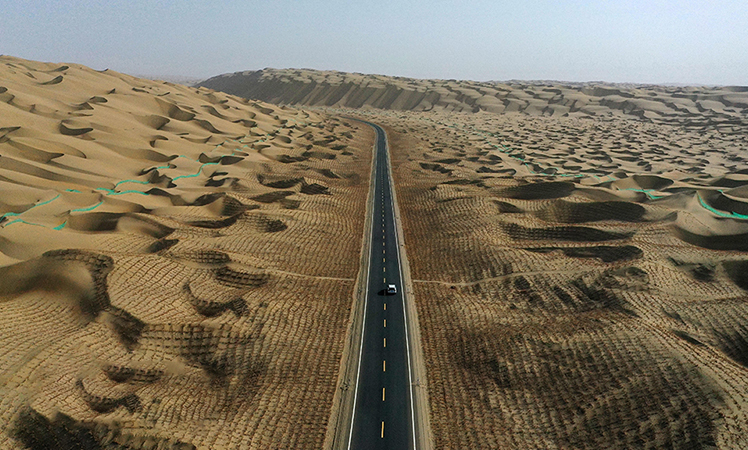Wondrous Xinjiang: Uygur vlogger offers glimpses into everyday life, changes in Xinjiang
URUMQI, July 5 (Xinhua) -- Aytuna Ablikim, 29, remembers the old crowded coaches that used to carry travelers over four days and three nights from Urumqi, capital of northwest China's Xinjiang Uygur Autonomous Region, to Hotan City in the south of the region.
Two drivers aboard would take turns steering to stay alert and guarantee the safety of their passengers. There were no sleeping berths in the cabins, and passengers had to endure the summer heat or the winter chill as there was no air conditioning.
These tiring journeys in her childhood memories have long been replaced by faster, safer and more comfortable travel experiences.
"When I was a child, I thought that Hotan was a very distant place. But later, the distance became gradually shorter because of the increasingly diversified methods of transportation," Aytuna Ablikim said.
Among the new modes of transport is a railway that was put into operation on June 16. The Hotan-Ruoqiang railroad stretches eastward from Hotan City to Ruoqiang County along the southern edge of the Taklimakan, the world's second-largest shifting-sand desert, with 65 percent of its length within the desert.
On the day the railway was launched, Aytuna Ablikim, a Uygur vlogger in her hometown of Moyu County, southern Xinjiang's Hotan Prefecture, witnessed the first train departure on a platform at Hotan station and captured the event to share it with her more than 1.6 million followers.
"Those involved in the construction of the project came to see more than four years of hard work bear fruit, and everyone had a smile on their face," she said.
She added that other people at the station were also excited as the first train departed. "Passengers aboard waved at us while many on the platform danced to the music."
The newly operational line extends 825 kilometers with a designated speed of 120 kilometers per hour. It has 22 stations, with six offering both passenger and cargo services and five providing only passenger services. Trains can cover the entire distance in just 11 hours and 26 minutes.
If people from counties without a railway station wanted to make a train journey previously, they had to first take a shuttle bus to Hotan City or travel to a railway station in another locale.
"However, with this railway, there will be no more detours for locals. People can bring their goods to other places to sell and teenagers can pursue better education out of their hometowns by train," she said.
The opening of the new rail line has brought an end to the lack of train services in five counties and certain towns in southern Xinjiang, and will shorten the travel time for locals, according to China Railway Urumqi Group Co., Ltd.
Aytuna Ablikim, born in Hotan and raised in Urumqi, was a regular traveler between the two locations throughout her childhood years.
"When I was little, the bus trip from Urumqi to Hotan took four days and three nights. The cramped bus had no air conditioning, so we had to keep the windows open for ventilation. It had no sleeping berths, so we sat up all night to sleep," she recalled. "Afterwards, we bumped along on a donkey cart for over a day before getting to our house."
The coaches were gradually equipped with air conditioning and sleeping bunks, and the time on the road was first shortened to two days, then to one day. With the continuous transportation development in Xinjiang, Aytuna Ablikim now has more diversified methods of transportation to choose from, including airplanes, trains and buses.
She has spent most of her life in Urumqi. After graduating from Xinjiang University in 2014, she worked for various companies in the regional capital.
It was in 2019 that she began to develop her career as a vlogger when she was working on a horse farm in Urumqi. "At the time, I thought many people might be interested in seeing the horses so I started making videos and livestreaming."
She set up an account on the popular Chinese short-video platform Douyin and uploaded videos or livestreamed content regularly. "In the videos, I showed what the horses ate, how they slept and the temperament of each horse, among other topics."
She gradually grew her fan base of more than 300,000 followers.
In 2020, because of the COVID-19 epidemic, Aytuna Ablikim decided to quit her job and return to Hotan to stay with her family. "It was the first time since 2014 that I stayed in my hometown for such a long time. After I returned, I was shocked by the vast changes and development that had taken place in Hotan over the years."
"When I was little, I fetched water with my cousins by donkey cart, but now we have tap water in our house. The former dirt roads in our county were replaced by asphalt roads. And the earthen houses my grandparents used to live in have been replaced by spacious brick ones," she said.
After returning to her hometown, she thought that her followers might not continue to subscribe to her account as she no longer posted videos of animals.
"At the beginning, I tried to upload videos centering on my life and found that my followers were interested as they urged me for more updates in my comment section," she said.
Since then, she has been keeping her lens focused on her everyday life and various aspects of Hotan, including culture, tourism and cuisine.
Without a photographer or a script, she captures what happens to her and her family. "I just record the real Xinjiang and the real Hotan," she said.
Currently, she has more than 1.6 million followers on more than 10 social media platforms.
"I think that making videos is meaningful because I can accompany my family, promote local specialties, and offer my followers glimpses into real life in Xinjiang all at the same time," she said.
More than two weeks into its operation, the Hotan-Ruoqiang railroad had already handled over 44,000 passenger trips and some 2,300 tonnes of cargo as of July 3, official data shows.
"When I take the train in the future, I will record the experience through video and share with my followers the scenery along the railroad, such as the golden populus euphratica trees in the autumn and the desert, which is not just associated with death, but also vitality," she said.
Photos
Related Stories
- Paper on employment in Xinjiang debunks "forced labor" lies
- U.S. politicians play “Xinjiang cards” against China while distorting facts about Xinjiang
- 2022 agricultural machinery expo held in Xinjiang
- Relocation creates happy new life for rural residents in NW China’s Xinjiang
- 5.2-magnitude quake hits China's Xinjiang: CENC
Copyright © 2022 People's Daily Online. All Rights Reserved.









